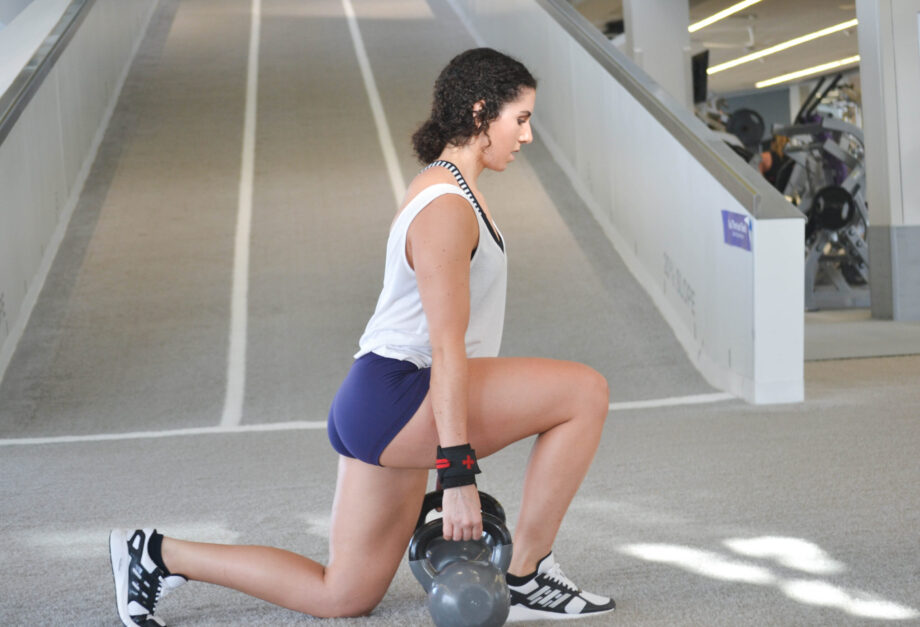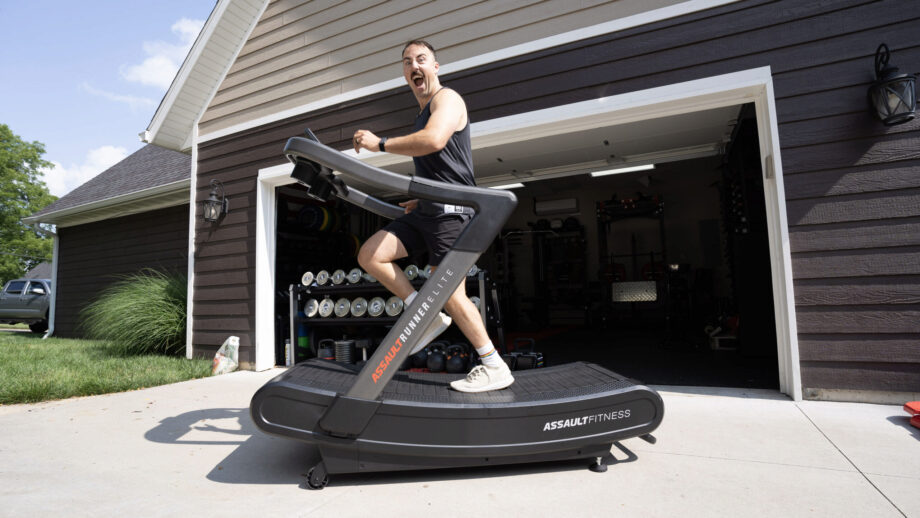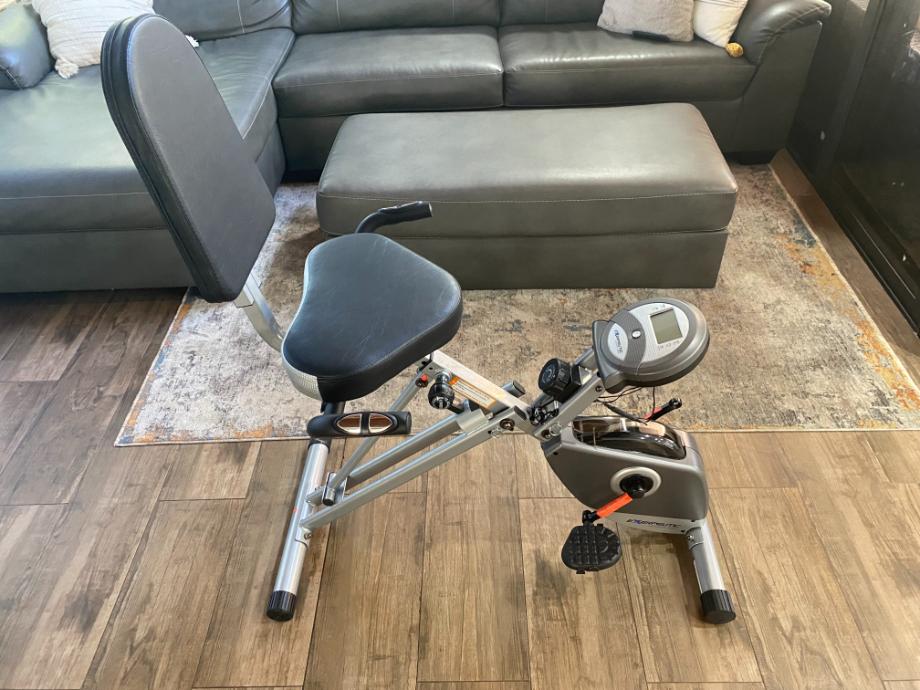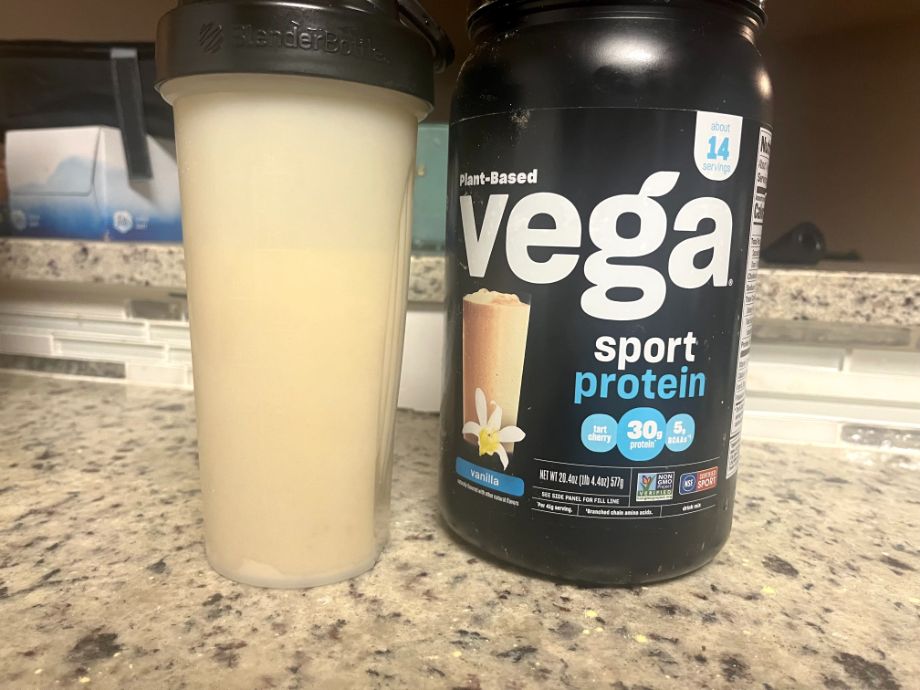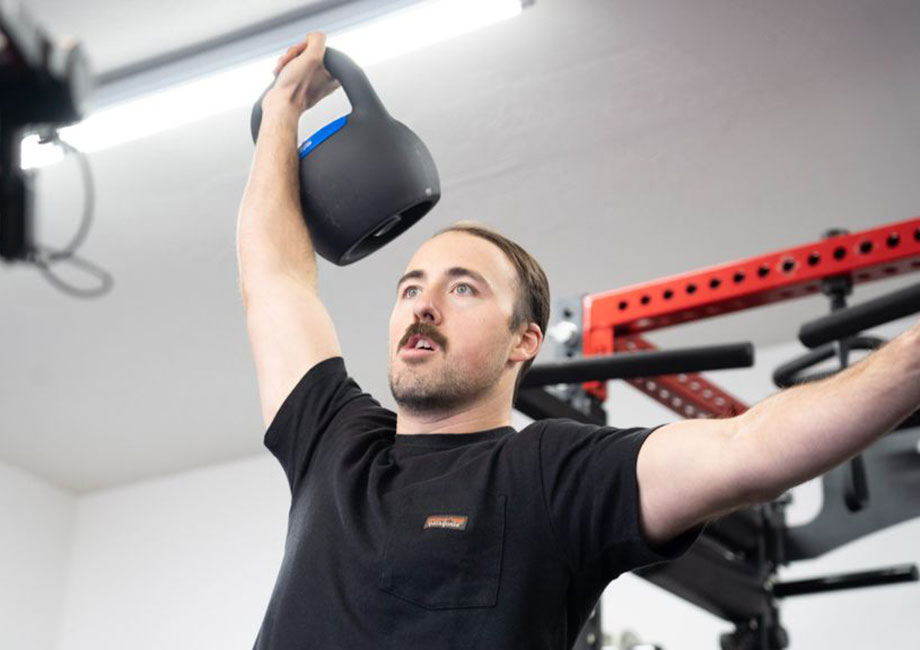Kettlebells have been around for a long time—by some accounts since the 1700s in Russia—and there’s a reason why.
The kettlebell is designed with a thick handle and offset center of mass, providing a unique challenge to your strength and stability. Your body is constantly adjusting because of the shifting center of mass, which provides a different stimulus than a dumbbell would.
This makes the kettlebell a great tool to help you reach your strength and performance goals. This article will dive into the 10 best kettlebell exercises, the benefits of kettlebell training, and the different types of kettlebells on the market to help you decide if kettlebell training is right for you. Spoiler alert: As a personal trainer, I think almost everyone can benefit from it. So, now that you have one of the best kettlebells, let’s go through some of the best ways to use it through these best kettlebell exercises.
10 Best Kettlebell Exercises
These 10 kettlebell exercises will work a variety of muscle groups and help you develop important skills, like the hip hinge and shoulder stability. Make sure to choose an appropriate kettlebell weight for each exercise—if you’re a beginner, opt for a lighter weight until you’ve logged enough repetitions to master the movement.
Kettlebell Swing
Swings are a fundamental kettlebell move that will improve your core strength, glute and hamstring power, cardiovascular fitness, and the look of your behind. It is a ballistic exercise that is high-intensity yet low-impact, and is the basis for several other movements on this list.
Muscles trained: Forearms, hamstrings, glutes, and lower back
How to do it:
- Stand with your feet wider than shoulder-width apart, with the kettlebell just in front of you.
- Hinge at the hips to grip the kettlebell with both hands and squeeze your armpits together with your chest up.
- Hike the kettlebell behind you and then thrust your hips forward, using this momentum to swing the kettlebell up.
- Finish the swing by squeezing your glutes and quads, bringing the kettlebell to eye level, then repeating in a continuous loop for reps.
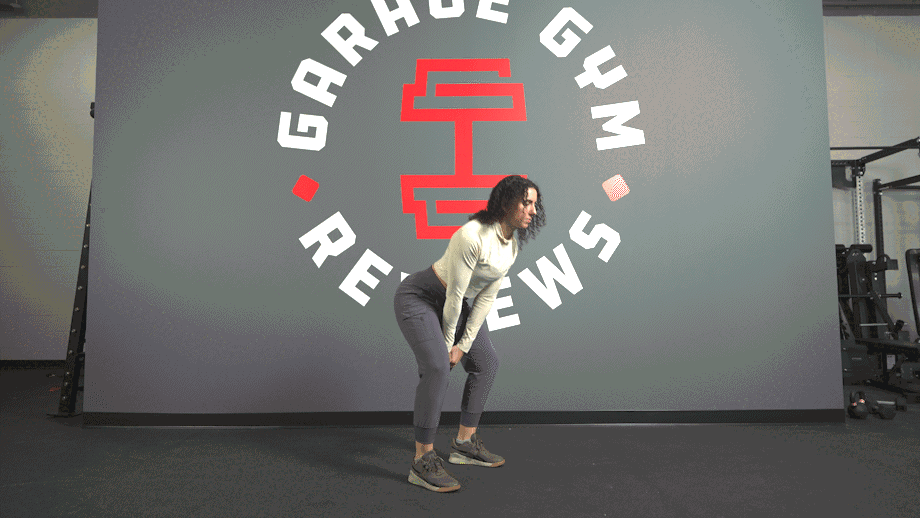
Kettlebell Goblet Squat
The goblet squat with a kettlebell was popularized by strength and conditioning coach Dan John as a way to teach people to squat between their knees and not over their knees. The kettlebell acts as a counterbalance to get you in a squat position to train your glutes, quadriceps, and anterior core strength.
Muscles trained: Anterior core, upper back, anterior deltoids, quadriceps, and glutes
How to do it:
- Hold a kettlebell at chest height with your shoulders down and chest up.
- Get your feet into your preferred squat position.
- Squat down, keeping your chest up and dropping down until your elbows touch your thighs.
- Stand up and finish with a squeeze of the glutes.
- Reset and repeat.
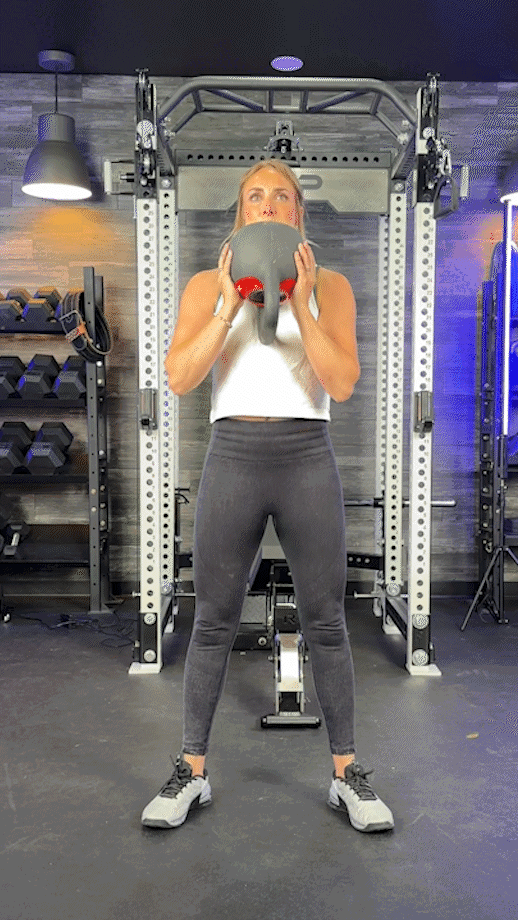
Kettlebell Snatch
The kettlebell snatch is a power exercise, like the swing. It’s an explosive movement that gets the posterior chain firing and core engaged, and it teaches you to stabilize the shoulder in the overhead position. This full-body exercise primarily trains the hamstrings, quads, back, and shoulder girdle but you’ll be feeling it from head to toe.
Muscles trained: Hamstrings, glutes, quadriceps, biceps, deltoids, and upper back
How to do it:
- Place one kettlebell between your feet on the ground and stand with your feet at hip-width apart.
- Hinge down and grip the kettlebell with the handle resting diagonally in your hand.
- Hike the kettlebell further back into a hip hinge and then snap it forward as you move through hip extension.
- As you’re rising, pull your elbow up until it can rise no further.
- Allow the power from your hips to punch your fist towards the ceiling. The KB should wrap around your wrist as your elbow reaches full extension.
- To release, begin to bend your elbow and flip the kettlebell back toward your forearm, dropping into another hip hinge to repeat the movement.
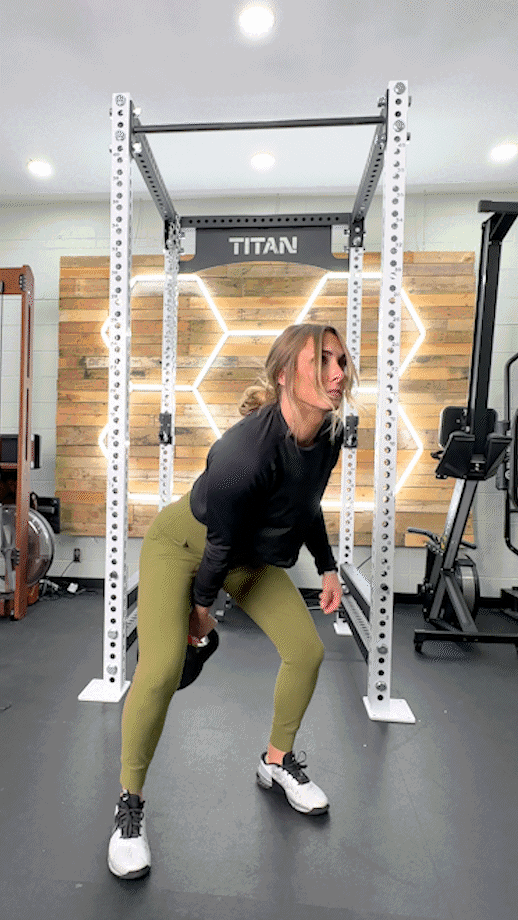
Single-Arm Kettlebell Clean
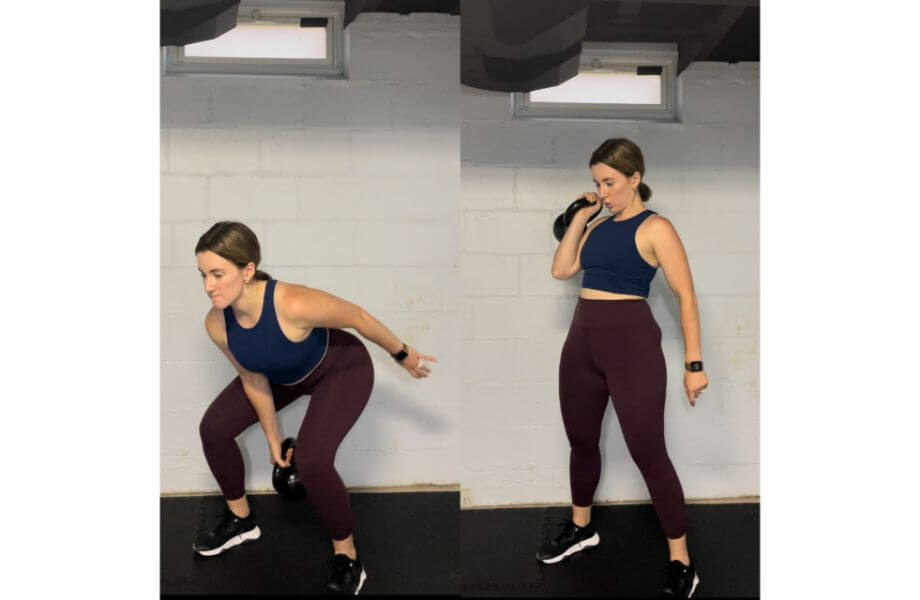
The kettlebell clean takes the kettlebell from the floor to the racked position against the chest at shoulder height in one fluid movement. Like the snatch, it trains most of the muscles in the body and is great for improving hip power. Plus, it forms the basis of many other kettlebell exercises. From the rack position, you can progress into an offset lunge or kettlebell clean and press.
Muscles trained: Quadriceps, glutes, hamstrings, deltoids, arms, and upper back
How to do it:
1. Have the kettlebell a foot in front of you with your feet hip-width apart. Hinge at your hips and grip the bell with an overhand grip.
2. Engage the lat on the working side, lift the opposite arm out for balance and pull the KB up between your legs.
3. Drive your feet through the floor, driving your hips forward and keeping the kettlebell close to your body to swing it to the rack position at your shoulder. In the rack position, your wrist should be neutral, your forearm vertical, and your elbow underneath the kettlebell.
4. Return to the starting position, reset and repeat.
Kettlebell Overhead Press
The kettlebell shoulder press from the rack position offers a more natural upward pressing motion, and in my opinion, is a comfortable and stronger position to press as opposed to the dumbbell or barbell. The kettlebell press is a great alternative to a barbell or dumbbell shoulder press.
Muscles trained: Deltoid, triceps, lats, upper traps, and core
How to do it:
- Clean the kettlebell to the rack position with your shoulder down, chest up, wrist in neutral, and feet shoulder-width apart.
- Press the kettlebell up with your hand rotating away from you to the lockout position, palm forward. Your biceps should be by or behind your ear.
- Slowly return to the rack position and rest, then repeat.
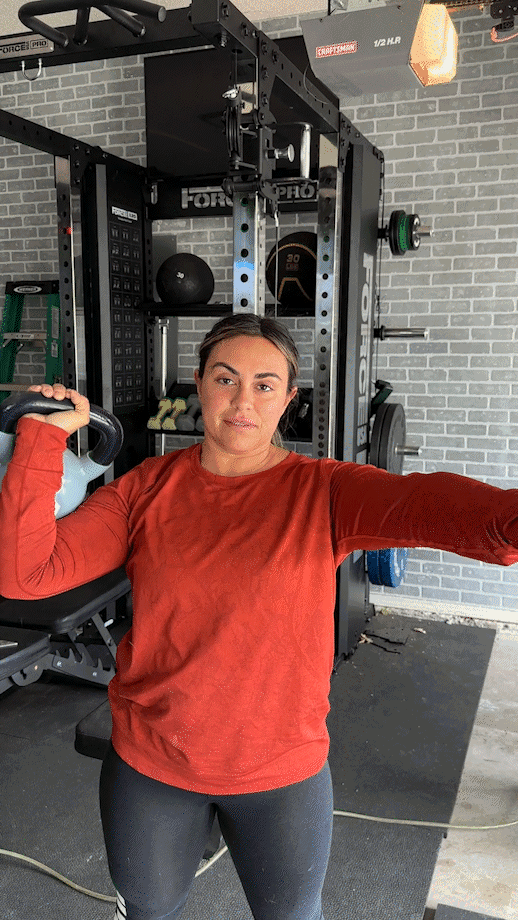
Kettlebell Bent-Over Row
Kettlebell rows will engage more of your upper- and lower-body stabilizing muscles and will improve core strength to a greater degree compared to a dumbbell because of the weight distribution. The grip demand from holding a kettlebell is something you’re going to enjoy, too. There are many variations on a kettlebell row, but this is my favorite.
Muscles trained: Forearms, biceps, rotator cuff, posterior deltoid, upper back, and lats
How to do it:
- With one or two kettlebells to your side and feet shoulder-width apart, hinge down and grip the kettlebell tightly.
- Keeping your shoulders down and chest up, row the KB towards the outside front of the hip. Send the elbows up and back, keeping them close to your body. Feel the contraction in your upper back and lats.
- Slowly return to the starting position, reset, and repeat.
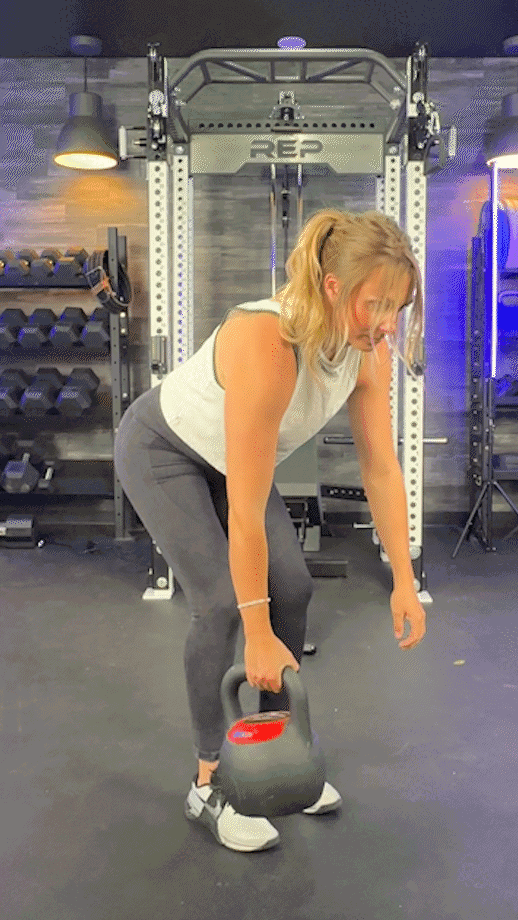
Kettlebell Windmill
The kettlebell windmill trains the whole body but focuses on improving the strength in your obliques, glutes, and shoulder overhead stability and mobility. It is an advanced exercise so start with a lighter-weight kettlebell to nail your form before progressing.
Muscles trained: Hamstrings, glutes, adductors, obliques and other core muscles, and deltoids
How to do it:
- Start with a kettlebell pressed overhead in your right hand with your feet hip-distance apart and feet rotated slightly toward the left for a greater range of motion.
- With your left arm in front of your thigh, hinge into your right hip sliding your left hand towards your foot.
- Keep hinging until your right hand is above your right shoulder in the overhead position. You should feel the weight shift into your right hip.
- Reverse to the starting position, keeping a neutral spine, then reset and repeat.
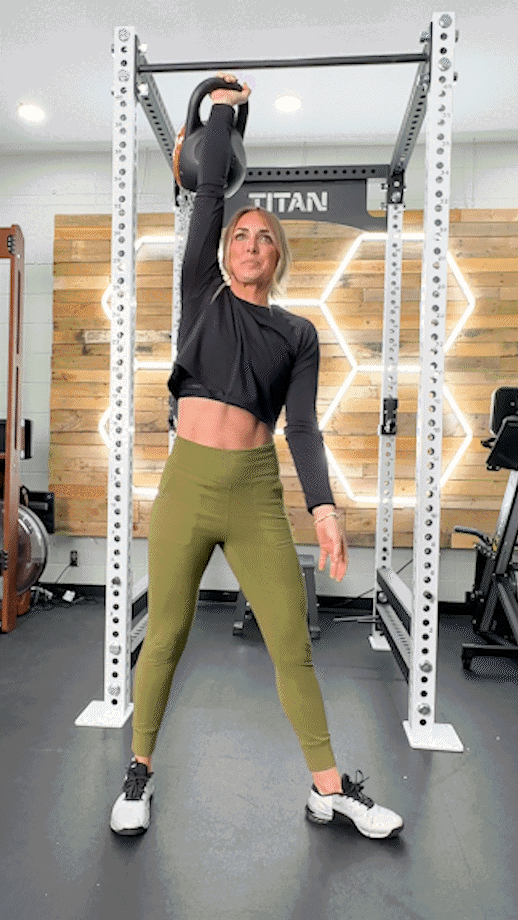
Kettlebell Thruster
When you’re short on time or want to improve full-body power and strength, the kettlebell thruster should be your go-to exercise. You’re training the squat and the press in one fluid movement, and it’ll burn your lungs as much as your muscles.
Muscles Trained: Quads, glutes, hamstrings, triceps, deltoids, and upper back
How to do it:
- Clean a kettlebell to the rack position.
- Squat down, keeping your chest up until you reach your preferred squat depth.
- Extend your hips to stand and start pressing the kettlebell overhead until lockout with your glutes and elbows.
- Return the kettlebell to the rack position, reset, and repeat.
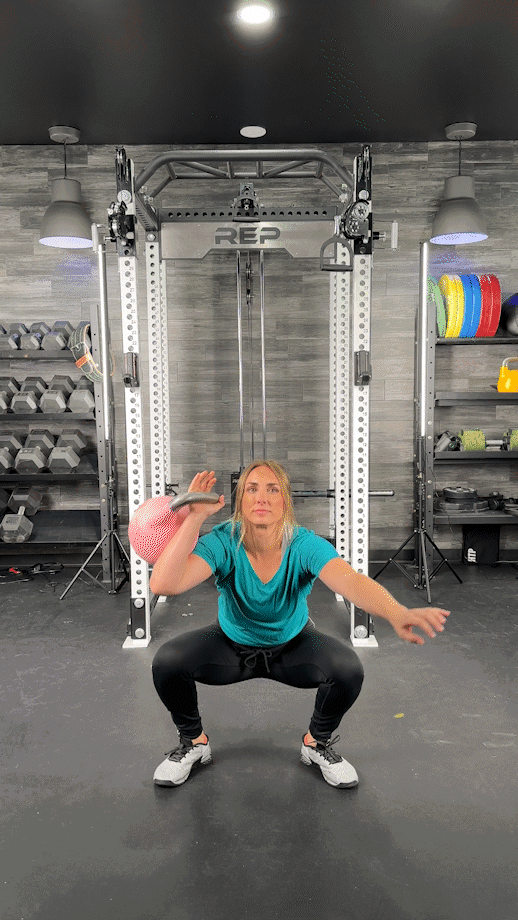
Kettlebell Turkish Get-Up
The Turkish Get-Up is a great exercise for strength, mobility, and cardio. Getting up and down from the ground using multiple upper and lower body muscles drives up your heart rate and improves your overall body strength and mobility.
Muscles trained: Almost all of them
How to do it:
- Lying on your side, grip a kettlebell with both hands and roll onto your back.
- With your back flat and the kettlebell in your right hand pressed with the weight overhead, put your right foot on the ground and slide your left leg out straight at a 45-degree angle. Do the same for your left arm.
- Push your right shoulder into the ground and roll to your left side, raising your right hip and pushing your left elbow down to help you get up.
- Straighten your left arm and sweep the left leg underneath you until you’re in the half-kneeling position.
- Sit up and push your right foot through the floor to stand up. Do the reverse to get back to the starting position.
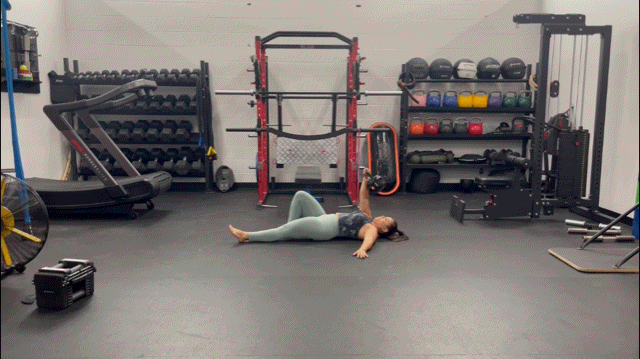
Kettlebell Single-Leg Romanian Deadlift
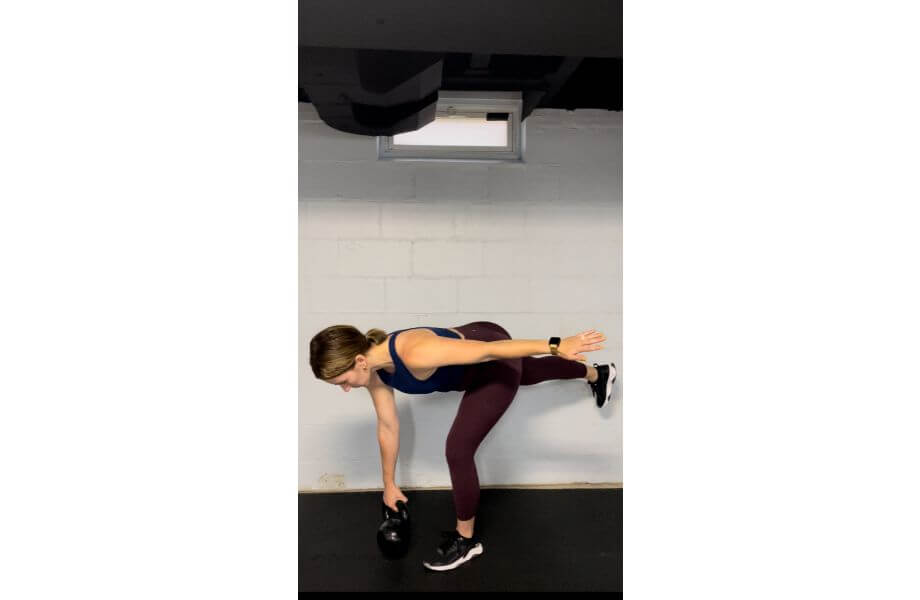
The kettlebell single-leg Romanian deadlift is a tough exercise with many benefits. You’ll improve balance and strengthen imbalances between sides, and reduce your risk of hamstring strains. The beauty of the kettlebell variation is you can come to a dead stop to reset your balance.
Muscles trained: Forearms, upper back, glutes, and hamstrings
How to do it:
- Hold a kettlebell in your right hand and pick up your right foot, finding balance on your grounded foot, and softening your left knee.
- Keep your chest up and shoulders down and hinge at your hips, keeping your back straight. Try not to open the hips.
- Hinge until your belly button is facing the floor and the kettlebell is on the ground.
- Stabilize and return to the starting position, then repeat.
Benefits of Kettlebell Training
Kettlebell training has plenty of benefits because of the unique movement patterns and weight distribution.
Grip Strength
Gripping the offset load, no matter what exercise you’re doing, will build real-world grip strength. When performing exercises like cleans, snatches, and swings for an extended time or reps, your grip muscles will get a workout with time under tension.
Better Power Development
Olympic lifts (snatch and clean-and-jerk) are the best power builders in the business, but they are highly technical and require time to learn. Kettlebell exercises like swings, snatches, and cleans train explosive hip power and the learning curve is shorter.
Improved Coordination and Mobility
A lot of kettlebell exercises require you to be coordinated and mobile. For example, a kettlebell snatch: You need coordination to get your hand in the right position to avoid the bell smashing into your wrists. Plus, you need shoulder mobility to settle the bell in the top position.
Versatility
This one tool has multiple uses depending on your goal. Train and improve power by doing swings and cleans—check. Improve your strength training performance by performing squats, presses, and rows—check. Improve your cardiovascular capacity and weight loss by doing circuits consisting of swings, thrusters, and snatches—check.
Improved Core Strength
Due to the offset center of mass, the kettlebell kicks the stabilizing muscles of your core, hips, and upper body into overdrive because every rep forces your body to work a little harder to keep the kettlebell on the straight and narrow.
How to Choose a Kettlebell
Choosing a kettlebell is dependent on your goals and budget. Here’s what you should keep in mind.
Traditional vs Competition-Style
There are two basic types of kettlebells to choose from: traditional cast iron or competition-style. Because competition kettlebells are made of pure steel, they are more expensive than their cast-iron counterparts. Competition kettlebells are also the same size regardless of weight, while cast iron kettlebells get larger as the weight increases.
Fixed vs Adjustable
There are either adjustable kettlebells or standard one-weight bells. Adjustable kettlebells are designed so the weight is variable—providing the utility of multiple kettlebells in one—and they are cheaper than buying an entire set of one-weight kettlebells. But, they’re not as durable as a single cast iron or steel bell and do require time and attention when changing the weight during a workout. If you’re wondering what the best kettlebell for strength is, either type will work—it just depends on your personal preference and goals.
Coating
Cast iron kettlebells are powder coated and may not be as durable as steel kettlebells, but the powder coating gives your skin and floor an extra layer of protection. You can also buy kettlebells covered with vinyl or other plastic coating—these are the least durable type, although they’re usually the least expensive.
If you’re competing or have an unlimited budget, a competition kettlebell is a worthwhile investment. If you’re just getting into kettlebell training or are looking to master some of the power movements, a more affordable cast-iron kettlebell will be suitable.
Final Verdict on Best Kettlebell Exercises
If you don’t know by now, kettlebells are awesome. You can use a kettlebell for a variety of exercises and the benefits include:
- Improved power
- Increased strength
- Improved coordination and mobility
- Supports fat loss when combined with a caloric deficit
And all this in one oddly shaped power package. Happy swinging!
FAQ’s About Best Kettlebell Exercises
Below are some frequently asked questions about the best kettlebell exercises.
Can you get ripped with kettlebells only?
Yes and no. The kettlebell will get you part of the way there, but you need to be in a calorie deficit while prioritizing protein to build muscle and achieve the ripped look.
Is a 20-minute kettlebell workout enough?
Yes, when the intensity is high like a high-intensity interval training (HIIT) workout and you’re performing full-body exercises like the ones on this list, 20 minutes is enough.
Are kettlebell workouts effective?
If your goal is to improve conditioning, power, and strength, then the kettlebell is an effective tool for all three as it provides a full-body workout.
Which kettlebell exercise burns the most fat?
It’s a close call between swings, cleans, and snatches. But due to the rhythmic nature and the ability to do extended sets and reps, I say kettlebell swings by a nose.


